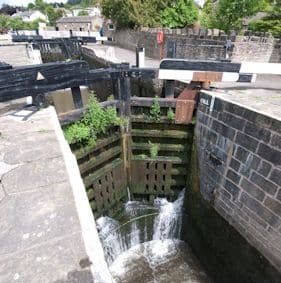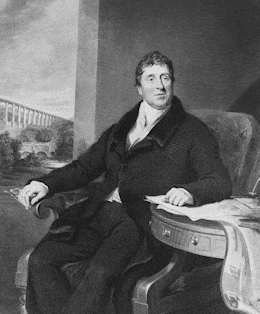The canal engineers, men who helped change the world
The civil engineering that went on during the fifty years of the canal boom was on a scale unprecedented in Britain. But in the middle of the eighteenth century when the canal boom began there was really no such thing as a civil engineer. Where did the engineering expertise and craft skills come from to plan the routes and execute the building works?
The First Civil Engineers
The most important engineers were probably mining engineers who had the difficult job of digging the mines and removing the water that flooded them, so much so that a contemporary definition of an engineer was “Engineers make engines for raising of water by fire…”. There were also estate managers and drainage engineers, such as the Dutch Vermuyden who was brought over by King James 1st to drain the Fen district of East Anglia (and was later imprisoned for draining marshes that the locals didn’t want draining!). There were additionally craftspeople like millwrights, used to working with water for waterpower. The supply, storage, harnessing and removal of water were important issues in the eighteenth century, so despite the absence of a civil engineering profession it was not difficult to find the brains, and the brawn, to rapidly develop the canal system. Hundreds of engineers were involved on thousands of projects, most of them never getting beyond the surveying stage. However some names keep reoccurring.
James Brindley (1716 – 1762)
James Brindley was employed to work on the building of the Bridgewater Canal with the Duke of Bridgwater’s land agent, John Gilbert (1724-1795), a mining expert. Brindley, of humble origins, was a millwright by training. He went on to act as senior engineer on the Trent and Mersey Canal.
When his fame spread he then became involved, in some capacity, in work on 363 other canal projects! Brindley had many assistants working for him, some of whom became well known as canal engineers, but the work load on him must have been enormous and he died in 1772 when only three of his canal projects, the Bridgewater Canal, the Droitwich Canal and the Staffordshire and Worcestershire Canal, had been completed.
Yet he set the standards for most of what followed, especially the dimensions for the narrow canals. His canals followed the contours, later engineers like Telford built more direct canals by using cuttings and embankments.
John Smeaton (1724 – 1792)
John Smeaton was the first Englishman to describe himself as a civil engineer. He wanted to gather other like minds to discuss their interests so he set up the Society of Civil Engineers in 1771. He started out as an instrument maker but became interested in windmills and watermills and other sources of power. He became well known and respected, a Fellow Of The Royal Society (F.R.S.) at the age of 29. He reconstructed the Eddystone Lighthouse and then became involved in canal and river surveying and engineering, doing his most successful work in Scotland (the Forth and Clyde Canal) and Ireland (the Grand Canal with Jessop).
William Jessop (1745 – 1814)
William Jessop was the son of a naval shipwright. His father Josias had worked with Smeaton on the the third Eddystone Lighthouse and when he died Smeaton took the young William under his wing and trained as an engineer. Jessop worked on many River Navigations and canals mainly in Eastern England and the Midlands and many consider him to be the greatest expert on canal and river navigations of his time. He was engineer on the Grand Junction (Grand Union Canal) and Ellesmere (Llangollen Canal) Canals and on the Rochdale Canal.
(All images on this page Wikipedia Creative Commons.)
He was also responsible for the East India docks in London and dock improvements in Bristol. His son Josias was a canal, railway and harbour engineer, notably during the construction of the Bristol Floating harbour.
Thomas Telford (1757 – 1834)
Thomas Telford was also from a humble background and began work apprenticed to a stonemason. His work was noticed while working as a stone hewer on the construction of Somerset House in London and after reconditioning Shrewsbury Castle he was appointed Surveyor of Public Works for Shropshire. He became engineer, beneath William Jessop, on the Ellesmere canal, later to become the Llangollen Canal. The magnificent cast iron aqueducts at Pontcycyllte and Chirk are his work, he reasoned that they would be less likely to suffer frost damage than Brindley’s which contained moist earth. He was chief engineer on the Liverpool and Birmingham Canal, now called the Shropshire Union Canal, making much use of long embankments and deep cuttings to create more direct routes than had his predecessors. He engineered the new Harecastle tunnel when Brindley’s could no longer cope alone with traffic levels and made improvements to the Birmingham Canal systems. He worked on canals in Europe and was involved in much road construction, designing the famous Menai suspension bridge between Anglesey and the North Wales mainland.
John Rennie (1761 – 1821)
John Rennie was a new type of university trained engineer. He worked as a millwright in his vacations but his first challenge was to design the steam powered Albion flour mills. He set up his business in London and became a prominent figure in the growing science and engineering establishment. He became surveyor, then engineer, on the Kennet and Avon Canal, one of the most architecturally impressive canals with its classical bridges and aqueducts. However he seems to have overlooked a basic rule of canal building, that the summit level of a canal must have sufficient supplies of water, and steam pumps had to be installed to replace water used by the locks. He also acted as engineer on the Rochdale Canal and Lancaster Canal, both with the same impressive feeling of scale as the Kennet and Avon. He had a wide range of interests, from designing docks to experimenting with diving bells.
All materials and images © Canal Junction Ltd. Dalton House, 35 Chester St, Wrexham LL13 8AH. No unauthorised reproduction.
About | Terms | Privacy| Refunds & Returns| Sitemap | Contact Us
With over 800 pages, this website uses cookies to record visitor behaviour using Google Analytics. More information on Privacy Page. Page last updated: 21/04/2025.






Back to Menu....
Canal Heritage >>
Engineering >>